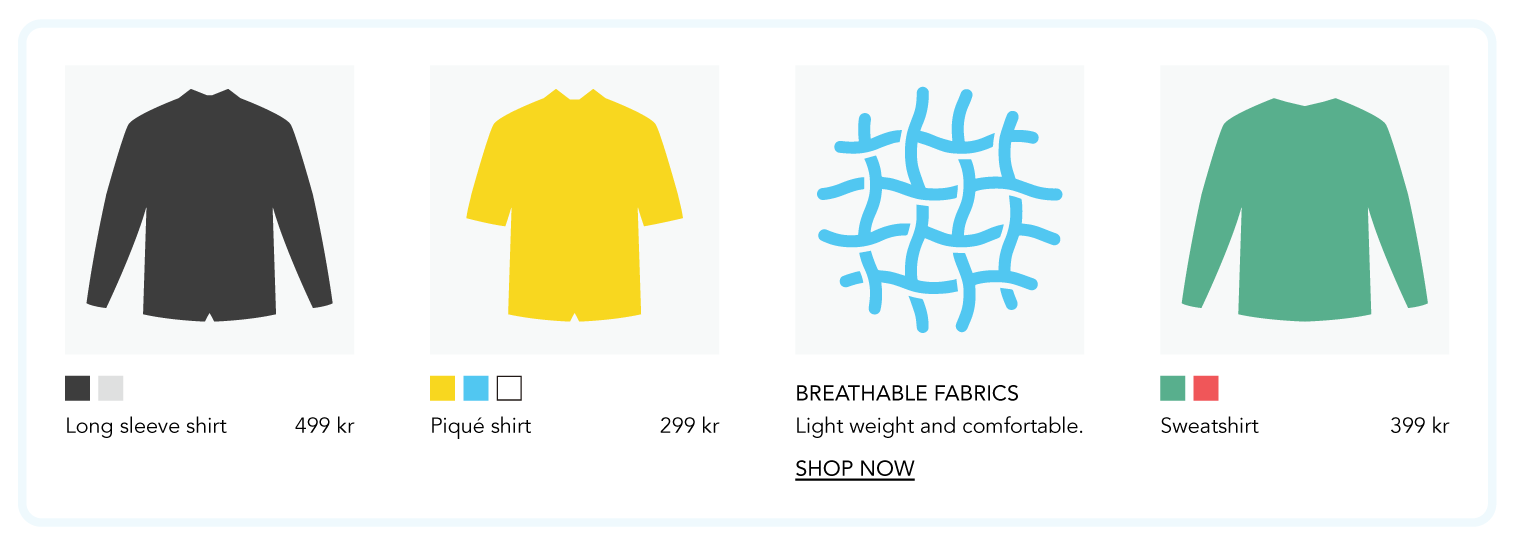Working with content¶
Content results, rather than purchasable product results, may be required in response to searches by visitors. It can be anything from size guides and articles about product care, manuals and installation instructions, to content not related to products such as shipping information and opening times for physical stores.
Content can be modeled as product or as an ad, rather than being a dedicated data entity type. A rule of thumb is to model content as a product when the content must be searchable and separated from ordinary products, and to model content as an ad when the content is tied to ordinary products. Content is imported into Elevate as any other product or ad.
Content as a product¶
Content as products are used for search with autocomplete and/or a search results page. The content search is commonly used on a specific part of a site to separate it from ordinary products, as when a visitor is in a section of a site that does not contain products they are most likely not searching for products.
Data modelling¶
The recommended way to indicate content in the data model is by adding an additional attribute type with the value content to a product. Other recommended attributes to include are attributes for a title, a URL, a description, and depending on how the content will be presented, a thumbnail image and/or a regular image. Keywords that are unique for the content can also be added. Note that all attributes that should be searched for must be configured as such.
<product>
<product_key>987654-0</product_key>
<type>content</type>
<locale>en-GB</locale>
<title>Shipping and Delivery</title>
<url>/shipping/</url>
<description>Worldwide delivery and multiple shipping options, including next-day delivery within the UK.</description>
<has_image>true</has_image>
<image_url>/images/shipping_large.jpg</image_url>
<has_thumbnail>true</has_thumbnail>
<thumbnail_url>/images/shipping_thumb.png</thumbnail_url>
<keywords>shipping|delivery</keywords>
</product>
To further separate content products from ordinary products, and to easier facilitate filtering, the additional attribute type can be added to ordinary products with the value product, i.e. <type>product</type>.
Usage¶
The panel used for content search is primarily the Autocomplete panel, and for the search results page, at least one Search hits panel or a zone that includes a search hits panel is used. To only show content products on a search results page or in the Autocomplete panel, filter the queries with type:'content'. In turn, searches for ordinary products should be filtered with either NOT type:'content' or type:'product'. A common practice for search result pages is to have one Search hits panel for ordinary products and one Search hits panel for content products, each with its own result count. When a visitor selects a returned content product, the site should redirect to the URL associated with it, as with any ordinary product.
Content products could be assigned to a specific category, such as a category for physical stores or a category for blogs, if a list of content matches is desired for that specific category selection.
When using the Autocomplete panel to return content products, a recommendation is to limit the number of returned items to 2 or 3, and separate the content product results from ordinary products.
Search phrase report impact¶
The Search phrase report will include content search matches as search hits. As results of a content search are never purchased, the number of purchases will always be 0 and the conversion rate will always be 0%.
Content as an ad¶
Content modeled as an ad is used when the content is related or relevant to a part of the assortment, for example when to showcase a shoe size guide in a specific shoe brand category, material and fabric information in a clothing category, or connect to products from a social media feed. The included or related attributes in an ad entity can be used to filter out products that are used to decide how relevant the content is in its current context.

Data modelling¶
No special changes to the ad data model is required. The included or related attributes are used to decide how relevant the ad is in its current context. Depending on the type of content and how it will be used, attributes can be added for social media accounts and images, connections to social media products, page type usage, and more. For more information, see Working with ads.
Usage¶
What panels to use depends on context, and what type of content is to be presented. Ads panels with product arguments are used for the underlying connected products and does not point directly to the ads.